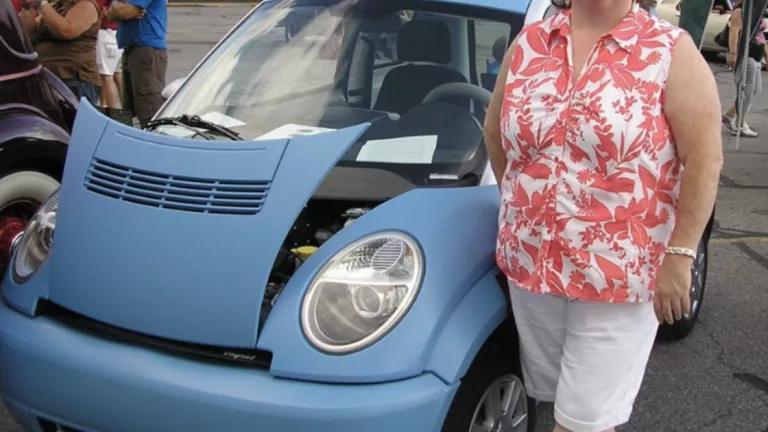
This is the eighth blog in a series about our Midwest electric vehicle adventure.
It’s well understood that installing adequate charging infrastructure—at frequent repeat destinations like homes, schools, and workplaces, as well as at destinations along highways better suited for long-distance travellers like us—is essential to achieving widespread electric vehicle (EV) adoption. Utilities, cities, and states in the Midwest and around the country are hearing this call to action and unveiling more and more major public charging plans. But there are some locations where the need still hasn’t been met.
Throughout our electric road trip, we’ve heard that many EV drivers, particularly early EV adopters, have been forced to become their own charging infrastructure advocates. Their work is, simply, awe-inspiring. But it also demonstrates why policy pushes for charging infrastructure—like those we’ve seen in Michigan, Ohio, and Missouri—are so important.
Making an EV Commute Easier in Indiana
While she certainly cares about air-polluting emissions, Jane Cook’s decision to go electric in 2011 stemmed from cost considerations. She ultimately chose to go electric because, when her old wheels were on their last breath, Jane could either afford gas for her weekly commute or loan payments for a new car, but not both. The cost savings associated with electric charging (versus buying gasoline) made an EV the only financially viable choice.
In 2011, there were fewer lower-cost EV options than there are today, so Jane purchased the Think EV (no longer manufactured), which had a range of around 90 miles. Her round-trip commute from Indianapolis to Lafayette, however, was just over 100 miles a day.
As a result, Jane needed to charge her car during the workday to be able to return home. But Jane’s workplace—and at the time, the public parking garages in Lafayette—didn’t have public charging available.
Jane found a solution: she began plugging her car into a standard 110 Volt wall outlet, or a Level 1 charger, the slowest charging option for EVs. (Read about charging levels, plugs, and more here.) But at the Level 1 charging rate, Jane couldn’t even fill up half her battery while she worked. This situation didn’t leave her with much wiggle room, particularly in cold Indiana winters, when low temperatures cause the range on the lithium-ion batteries that power EVs to decrease.
Jane found a solution for that too. Jane led a six-month charge to advocate that the city and its local utility, Duke Energy, work together to install a public Level 2 charger in the city-owned parking garage near her workplace. A Level 2 charger could make a world of difference: unlike the Level 1 wall outlet, a Level 2 charger could completely recharge a small EV battery in a matter of hours. Although the utility had dedicated funding and a program to cover a substantial portion of the costs of the installation, Jane had to overcome numerous obstacles to navigate the project through city government.
By the time the charger was finally installed, Jane had already taken a new job and needed to charge her EV elsewhere. But, as she told us, she was glad that the charger would support other EV drivers.
Thankfully, cities and workplaces are increasingly getting the memo that supporting EVs by installing charging infrastructure produces happier commuters, healthier air, and lower electricity rates. And making chargers available at workplaces creates a virtuous cycle by boosting EV deployment, especially because more than half of the EV charging that happens away from the home happens at work.
Midwest EVOLVE, a partnership between the American Lung Association and Midwestern Clean Cities Coalition, has worked with a number of companies to install workplace charging at sites including the Ohio State University in Columbus to the Target Corporation in Minneapolis.
And on the public parking side, cities like Chicago and Indianapolis are considering adopting EV ready ordinances that would require public Level 2 EV charging (or at least wiring that can support Level 2 EV charging) in all new public parking structures.
Encouraging Electric Travelers in Illinois
When we pulled into our hotel in Champaign, the Illini Union Hotel associated with the University of Illinois, we were pleasantly surprised by the beauty of the red-brick building and its white-trimmed windows. Like some of our favorite lunch stops along our journey, we chose the hotel only for the Level 2 charging station in its parking lot, which would allow us to plug in our car overnight and wake up to a fully-charged battery in the morning.

When we arrived at our second destination in the Champaign area, the home of Professor Scott Willenbrock, the particle physicist humbly told us that he was the person to thank for the hotel charger. As he put it, “That’s when I learned how hard advocacy is.”

Scott explained that even on a campus renowned for its engineering, getting the charger installed involved bouncing between different university departments. The eventual result of Scott’s advocacy is a conveniently-located Level 2 charger that enables not only workplace charging for university employees, but also destination charging for travelers like us.
While workplace charging is important to boost local use of EVs, destination charging is important to help realize EVs’ potential, not just as commuter cars, but as full-purpose vehicles perfect for travel. (1,600+ miles later, we sure know they are.) Having chargers in public parking garages and other locations is definitely helpful for overnight stays, but having chargers at hotels makes a clean car road trip like ours even easier.
Local policies—in cities, but also institutions like universities—can accelerate the process so that hotels that lack charging heroes like Scott can secure chargers. Chicago, for instance, implemented an Easy Permit Process ordinance in 2017 that dramatically streamlines the process of getting a permit to install an EV charger: now a licensed electrician just needs to wait one day for the approval to install a charger in a single-family home. In the case of multi-family homes or businesses, the Illinois Department of Commerce and Economic Opportunity will refund up to half of the equipment and installation costs.
Moving Policy Forward
The transition to EVs is coming. Localities need to embrace transportation electrification and its clean air, human health, and economic benefits. As Jane and Scott’s stories reveal, sometimes the biggest barriers are simply awareness and coordination between different parties.
Luckily, resources to educate companies, universities, cities alike on the opportunities represented by well thought out charging infrastructure have proliferated as EV sales have accelerated. Policy that supports charging infrastructure can further strengthen EV adoption. We deeply admire Jane and Scott’s advocacy and tenacity. We’re grateful for their willingness to go the extra mile as individual EV champions. We hope their stories spur more EV drivers to action—and inspire policymakers to meet them halfway.
We went on a Midwest electric vehicle road trip to talk about transportation policy, highlight the already booming benefits of electric vehicles to local economies, and shatter stereotypes about what it means to be an electric vehicle driver. We’re blogging about our findings, including tips for other aspiring roadtrippers and policy suggestions for further progress.
Other blogs related to our electric adventure include:
Driving (on) Clean Energy: Touring the Midwest in an EV
State of the States: EVs and EV Policy in the Midwest
Road Trip Report: How Ohioans Buy EVs (It Should Be Easier)
Avoiding Range Anxiety with an EV Road Trip Checklist
Road Trip Report: Midwest Cities Move Multimodal
Midwest Electric Vehicles in 5 Maps
Electric Vehicle Charging Basics



